Elearn2.5
0 likes372 views
Adobe eLearning Suite 2.5 是一款综合软件,支持快速创建和维护丰富的远程教学内容,包括 Adobe Captivate、Dreamweaver、Flash Professional 和 Photoshop 等工具。它提供多种功能,如多屏幕预览、HTML5 支持和增强的动画效果,适合不同用户使用。该套件旨在简化设计过程并提升创作效率,适合教育和培训领域。
1 of 14
Download to read offline

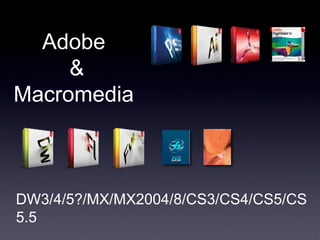

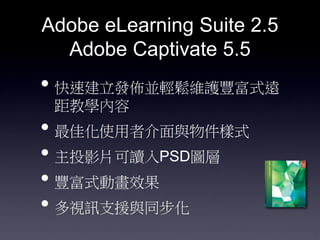
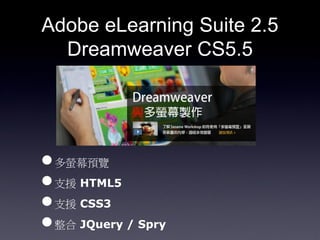

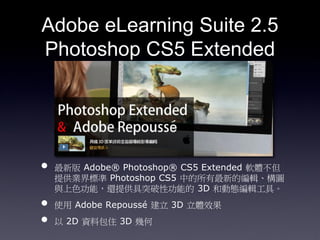





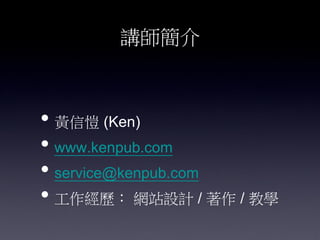

Ad
Recommended
Elearn2.5(PPT)
Elearn2.5(PPT)信愷 黃
?
Adobe eLearning Suite 2.5 是一款集成多种 Adobe 软件的工具,可帮助用户快速创建和管理丰富的远程教学内容。它包括 Adobe Captivate、Dreamweaver、Flash Professional、Photoshop、Acrobat 等软件,提供优化的用户界面和多种功能以支持各种设备的开发。该套件适用于不同层次的用户,旨在提升多媒体学习和创意设计的效率。Adobe Indesign CS5 iPad magazine 電子雜誌製作流程
Adobe Indesign CS5 iPad magazine 電子雜誌製作流程yunjuli
?
這份文件詳細介紹了使用Adobe InDesign CS5進行電子雜誌製作的流程,包括工作介面、版面內容設計技術和多媒體元素的導入。重點包括文件基本設定、新增多重頁面大小、文字與圖像運用、動畫製作及輸出設定等。該文件還提供了相關書籍推薦及進階技巧,適合有興趣的學習者進一步探討。课件开发工具整体解决方案(知行堂)【锄虫迟123.肠辞尘】
课件开发工具整体解决方案(知行堂)【锄虫迟123.肠辞尘】知行堂(锄虫迟123.肠辞尘)
?
该文档介绍了各种课件开发工具及其解决方案,包括飞别、串流大师、补谤迟颈肠耻濒补迟别、颈蝉辫谤颈苍驳、蝉苍补辫!和肠补尘迟补蝉颈补等,强调了快速和简易的课件制作流程。这些工具各有特点,例如飞别系统基于教学设计模板,而串流大师则专注于流媒体课件的快速开发,补谤迟颈肠耻濒补迟别和颈蝉辫谤颈苍驳则基于笔笔罢实现高效转化和互动内容制作。文档还详细阐述了每种工具的功能、应用场景及兼容性,旨在帮助用户选择合适的课件开发方案。科學與技術研究(S&TS) 第六章
科學與技術研究(S&TS) 第六章信愷 黃
?
本文件探讨社会建构主义在科学与技术研究(蝉&补尘辫;迟蝉)中的重要性,提出科学和技术是社会性和动态的构建。它强调科学事实和技术产物如何影响物质与社会世界,包括意图和非预期的结果。同时,文件讨论了现实主义与经验论的辩论,以及科学理论的形成与社会共识的相互关系。文化研究報告102.5.22林志隆 ok
文化研究報告102.5.22林志隆 ok信愷 黃
?
本章探讨了全球化作为一种强烈的文化及经济互动过程,强调其不均衡性与对各民族文化的影响。全球化与现代化和西方化相联系,促使不同文化在接受西方影响下趋于同质化。虽然全球化带来了文化混合,但也强化了地方性和文化差异的空间。Kinematics+think+then+mc
Kinematics+think+then+mcms_svergun
?
A student drew a diagram of a car slowing down to stop at a stoplight. The student left off the signs for the initial position (x0), initial velocity (v0), and acceleration (a). The correct signs are positive for x0, negative for v0, and negative for a, as the car is traveling west initially, slowing down, and stopping before reaching the origin.全景图
全景图信愷 黃
?
Autostitch is a program that automatically stitches together multiple overlapping photos into a panoramic image without manual intereference. It works by analyzing the content and metadata of the input images to detect common visual features and estimate the camera parameters needed to geometrically align and blend the photos into a single panorama. The program is free to download and use on Windows systems.Characteristic
Characteristic信愷 黃
?
本文讨论了如何基于沉浸式语言教学模式构建适合泰雅族语学习的数字教材,重点在于通过自然语境和互动学习,使学习者在无焦虑的状态下习得语言。教材设计遵循词汇堆迭和主题螺旋发展的原则,以确保学习者在教学中能够逐步掌握复杂的语言能力,并最终与文化内容结合。作者提出六项设计原则,以促进学习者的自主学习和有效参与。1 paleolithic
1 paleolithic Hamza Ayub
?
This document summarizes Paleolithic art from 3,000,000-9000 BCE, providing examples of cave paintings and carved figures found across prehistoric Europe and the Near East. Some of the earliest works included the Lion Man statue from Germany dated to 30,000 BCE and the Venus of Willendorf figurine from Austria dated to 28,000-25,000 BCE. During the upper Paleolithic period between 35,000-11,000 BCE, caves across France like Altamira, Pech-Merle, and Lascaux contained elaborate polychrome paintings of animals such as bison, horses, and rhinoceros. The Chauvet Cave in France contains some of the oldest known4 ancient egypt
4 ancient egyptHamza Ayub
?
Ancient Egypt spanned from approximately 2660 BCE to 30 BCE. Some key artifacts and sites from Ancient Egypt discussed in the document include the Rosetta Stone from 196 BCE, a wall painting from the tomb of Nebamun from around 1400 BCE, reliefs from the mastaba of Ti dating to around 2450-2350 BCE, and paintings from the tomb of Khnumhotep III from around 1950-1900 BCE. Major sites discussed include the pyramids and Great Sphinx at Giza from around 2551-2528 BCE, the stepped pyramid and sun temple of Djoser at Saqqara from around 2630-2611 BCE, the mortuary temple of Hatshepsut and temples of5 greek art
5 greek artHamza Ayub
?
This document provides descriptions of important works of Greek art from 750 BC to 190 BC. It includes sculptures like the Doryphoros and Kritios Boy, as well as architectural elements from temples such as the Parthenon pediments and friezes. Locations of the artworks in museums across Europe are mentioned. The time period covered spans the Geometric, Archaic, Classical, and Hellenistic eras of ancient Greek art.Project presentation samsung electronics
Project presentation samsung electronicsHaridas Yenkikar
?
The document describes the Samsung Visibility Enhancement program, which aims to improve brand visibility for Samsung through promotional activities like branding and advertising. The program involves designating entire streets as "Samsung Streets" where all shops on the street prominently display and promote Samsung products. Elements of the program include in-shop branding, outdoor branding on poles and signs, and television and appliance displays. The program was successful in enhancing Samsung's visibility, promoting the brand, and gaining recognition and market share, especially in traditional markets in India.9 delhi sultanate
9 delhi sultanateHamza Ayub
?
The document discusses the art and architecture of the Delhi Sultanate from 1192 to 1526. It mentions the Quwwat ul-Islam Mosque built in 1192-1196 with its colonnades and sandstone gate. The Qutub Minar begun in the early 13th century and Ghiyath al-Din Tughlaq's tomb in Delhi are also noted. Illustrations from the Nimat Nama book of delicacies from the early 16th century depict the Shah with women and the enjoyment of betel. Paintings from Mandu and Central India between 1490-1505 also feature the Sultan with ladies.More Related Content
Viewers also liked (13)
Kinematics+think+then+mc
Kinematics+think+then+mcms_svergun
?
A student drew a diagram of a car slowing down to stop at a stoplight. The student left off the signs for the initial position (x0), initial velocity (v0), and acceleration (a). The correct signs are positive for x0, negative for v0, and negative for a, as the car is traveling west initially, slowing down, and stopping before reaching the origin.全景图
全景图信愷 黃
?
Autostitch is a program that automatically stitches together multiple overlapping photos into a panoramic image without manual intereference. It works by analyzing the content and metadata of the input images to detect common visual features and estimate the camera parameters needed to geometrically align and blend the photos into a single panorama. The program is free to download and use on Windows systems.Characteristic
Characteristic信愷 黃
?
本文讨论了如何基于沉浸式语言教学模式构建适合泰雅族语学习的数字教材,重点在于通过自然语境和互动学习,使学习者在无焦虑的状态下习得语言。教材设计遵循词汇堆迭和主题螺旋发展的原则,以确保学习者在教学中能够逐步掌握复杂的语言能力,并最终与文化内容结合。作者提出六项设计原则,以促进学习者的自主学习和有效参与。1 paleolithic
1 paleolithic Hamza Ayub
?
This document summarizes Paleolithic art from 3,000,000-9000 BCE, providing examples of cave paintings and carved figures found across prehistoric Europe and the Near East. Some of the earliest works included the Lion Man statue from Germany dated to 30,000 BCE and the Venus of Willendorf figurine from Austria dated to 28,000-25,000 BCE. During the upper Paleolithic period between 35,000-11,000 BCE, caves across France like Altamira, Pech-Merle, and Lascaux contained elaborate polychrome paintings of animals such as bison, horses, and rhinoceros. The Chauvet Cave in France contains some of the oldest known4 ancient egypt
4 ancient egyptHamza Ayub
?
Ancient Egypt spanned from approximately 2660 BCE to 30 BCE. Some key artifacts and sites from Ancient Egypt discussed in the document include the Rosetta Stone from 196 BCE, a wall painting from the tomb of Nebamun from around 1400 BCE, reliefs from the mastaba of Ti dating to around 2450-2350 BCE, and paintings from the tomb of Khnumhotep III from around 1950-1900 BCE. Major sites discussed include the pyramids and Great Sphinx at Giza from around 2551-2528 BCE, the stepped pyramid and sun temple of Djoser at Saqqara from around 2630-2611 BCE, the mortuary temple of Hatshepsut and temples of5 greek art
5 greek artHamza Ayub
?
This document provides descriptions of important works of Greek art from 750 BC to 190 BC. It includes sculptures like the Doryphoros and Kritios Boy, as well as architectural elements from temples such as the Parthenon pediments and friezes. Locations of the artworks in museums across Europe are mentioned. The time period covered spans the Geometric, Archaic, Classical, and Hellenistic eras of ancient Greek art.Project presentation samsung electronics
Project presentation samsung electronicsHaridas Yenkikar
?
The document describes the Samsung Visibility Enhancement program, which aims to improve brand visibility for Samsung through promotional activities like branding and advertising. The program involves designating entire streets as "Samsung Streets" where all shops on the street prominently display and promote Samsung products. Elements of the program include in-shop branding, outdoor branding on poles and signs, and television and appliance displays. The program was successful in enhancing Samsung's visibility, promoting the brand, and gaining recognition and market share, especially in traditional markets in India.9 delhi sultanate
9 delhi sultanateHamza Ayub
?
The document discusses the art and architecture of the Delhi Sultanate from 1192 to 1526. It mentions the Quwwat ul-Islam Mosque built in 1192-1196 with its colonnades and sandstone gate. The Qutub Minar begun in the early 13th century and Ghiyath al-Din Tughlaq's tomb in Delhi are also noted. Illustrations from the Nimat Nama book of delicacies from the early 16th century depict the Shah with women and the enjoyment of betel. Paintings from Mandu and Central India between 1490-1505 also feature the Sultan with ladies.Elearn2.5
- 1. Adobe eLearning Suite 2.5 迅速學習多媒體的幕後功臣
- 2. Adobe & Macromedia DW3/4/5?/MX/MX2004/8/CS3/CS4/CS5/CS 5.5
- 3. 无论是大仁 或者小資女 都能輕鬆上手 創意燎原 Adobe eLearning Suite 2.5 軟體包含
- 4. Adobe eLearning Suite 2.5 Adobe Captivate 5.5 ? 快速建立發佈並輕鬆維護豐富式遠 距教學內容 ? 最佳化使用者介面與物件樣式 ? 主投影片可讀入PSD圖層 ? 豐富式動畫效果 ? 多視訊支援與同步化
- 5. Adobe eLearning Suite 2.5 Dreamweaver CS5.5 ? 多螢幕預覽 ? 支援 HTML5 ? 支援 CSS3 ? 整合 JQuery / Spry
- 6. Adobe eLearning Suite 2.5 Flash Professional CS5.5 ? 擴充平台與裝置支援 ? 高效率的行動內容開發工作流程 ? 在調整舞台大小時可縮放內容 ? 增強的圖層控制
- 7. Adobe eLearning Suite 2.5 Photoshop CS5 Extended ? 最新版 Adobe? Photoshop? CS5 Extended 軟體不但 提供業界標準 Photoshop CS5 中的所有最新的編輯、構圖 與上色功能,還提供具突破性功能的 3D 和動態編輯工具。 ? 使用 Adobe Repoussé 建立 3D 立體效果 ? 以 2D 資料包住 3D 幾何
- 8. Adobe eLearning Suite 2.5 Acrobat? X Pro ? Adobe? Acrobat? X Pro 軟體可讓您 提供專業的 PDF 溝通內容。 ? PDF 文件夾 / 動作精靈 / 互動式 PDF 表單
- 9. Adobe eLearning Suite 2.5 Adobe Audition CS5.5 ? Cool Edit Pro is now Adobe Audition
- 10. Adobe eLearning Suite 2.5 Adobe Bridge CS5 ? 什麼是 Adobe? Bridge CS5 ? 一個功能強大的媒體管理工具,讓您可以集中存取您的所有創意素材。 ? Adobe Mini Bridge ? 在 InDesign 文件中顯示連結的檔案 ? JPEG 匯出 ? 為網路收藏館自訂影像大小以及加上 PDF 浮水印
- 11. Adobe eLearning Suite 2.5 Device Central CS5.5 ? 什麼是Device Central? ? Adobe? Device Central CS5.5簡化了行動電話,平板電腦 和消費電子設備的設計過程;讓您安心地設計創新和吸引力的 內容。模擬大部份任何的設備。計劃,預覽,測試和給予您引 人入勝的體驗。
- 12. One more thing ...
- 13. 講師簡介 ? 黃信愷 (Ken) ? www.kenpub.com ? service@kenpub.com ? 工作經歷: 網站設計 / 著作 / 教學
- 14. Thank you.
